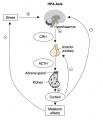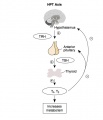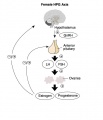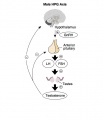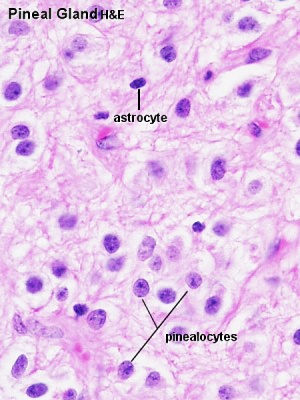ANAT2241 Endocrine System
| ANAT2241 This practical support page content is not part of the virtual science practical class and provides additional information for student self-directed learning purposes. All practical class pages are located on Moodle - ANAT2241 |
General Objective
To know the histological and cytological features and hormones of the endocrine glands.
Specific Objectives
- To know the structure of the thyroid and parathyroid glands and the hormones secreted.
- To know the histology of the adrenal cortex and medulla and the hormones secreted by each section.
- To understand the close relationship between the hypothalamus and the pituitary.
- To know the parts of the hypophysis (pituitary). To identify chromophil (acidophil, basophil) and chromophobe cell types of the pars distalis and the hormones associated with each group of cells. To describe the structure of the neurohypophysis and the process of neurosecretion.
- To know the histology of pancreatic islet cells and their hormonal secretions.
Learning Activities
Examine the following virtual slides, identify draw and label the following structures. Note the hormone secreted by the various structures and their major function.
Virtual Slides: Endocrine System
Endocrine Axes
Many of the endocrine organs act together as part of a signalling axis, beginning with the hypothalamus. There is also a sex-specific axis for female (ovary) and male (testis), both identified as gonad.
Histology
Note this support page includes additional endocrine gland histology that may not be covered in the current practical class, or has been covered in previous classes in the course.
Pineal
Pineal (high power)
Thyroid
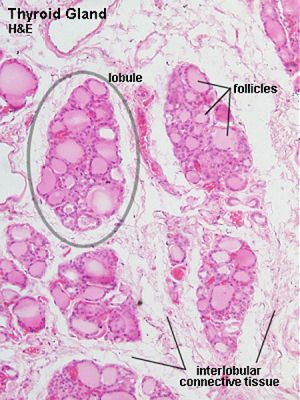
|
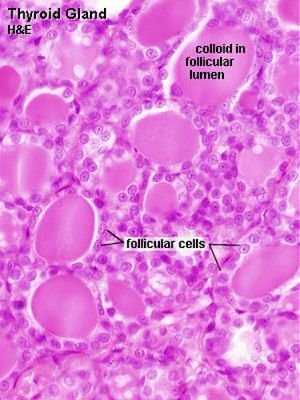
|
| Thyroid (low power) | Thyroid (high power) |
- Thyroid Links: low power image | high power image | unlabeled human image | unlabeled sheep image | thyroid
Parathyroid
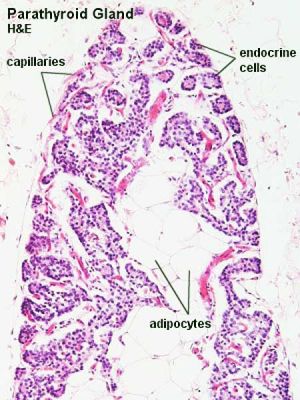
|
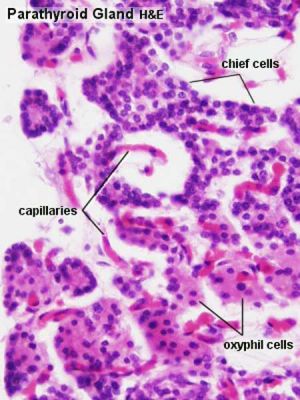
|
| Parathyroid (low power) | Parathyroid (high power) |
Pancreas
The specific cell types within the pancreatic islets cannot be identified by routine histology staining and require specialised immunostaining techniques.
Pancreatic Islet - Endocrine cells from human (fetal and adult) and mouse (adult) pancreas.
Pituitary

|
The shape of the bone base of the skull surrounding the pituitary led to the naming sella turcica (Latin, sella = saddle; turcica = Turkish), as when first identified the bony space resembled this saddle shape. | 
|
| Pituitary - Adenohypophysis | ||
|---|---|---|
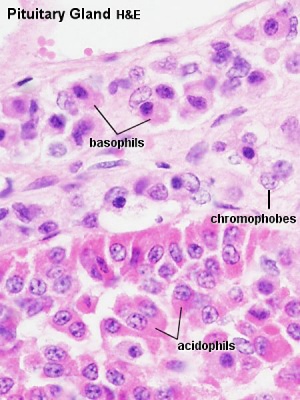
|

|
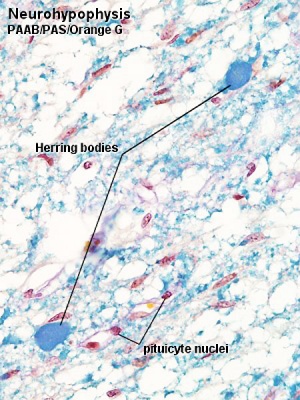
|
- Pituitary Histology: Pituitary overview | Anterior H&E | Anterior H&E | Anterior labeled | PAS/O Overview | Acidophils | Basophils | Posterior labeled | Posterior unlabeled | Histology Stains | BGD - Endocrine Histology | Pituitary Development
Adrenal
Course Links
- Histology Glossary: A | B | C | D | E | F | G | H | I | J | K | L | M | N | O | P | Q | R | S | T | U | V | W | X | Y | Z | ANAT2241 Support | Histology | Histology Stains | Embryology Glossary
| Common Histology Stains | ||||||||||||||||||||||||||||||||||||||||||||||||||||||||||||||||||||||||||||||||||||||||||||||||||||||||||||||||||||||||||||||||||||||||||||||||
|---|---|---|---|---|---|---|---|---|---|---|---|---|---|---|---|---|---|---|---|---|---|---|---|---|---|---|---|---|---|---|---|---|---|---|---|---|---|---|---|---|---|---|---|---|---|---|---|---|---|---|---|---|---|---|---|---|---|---|---|---|---|---|---|---|---|---|---|---|---|---|---|---|---|---|---|---|---|---|---|---|---|---|---|---|---|---|---|---|---|---|---|---|---|---|---|---|---|---|---|---|---|---|---|---|---|---|---|---|---|---|---|---|---|---|---|---|---|---|---|---|---|---|---|---|---|---|---|---|---|---|---|---|---|---|---|---|---|---|---|---|---|---|---|---|
| ||||||||||||||||||||||||||||||||||||||||||||||||||||||||||||||||||||||||||||||||||||||||||||||||||||||||||||||||||||||||||||||||||||||||||||||||
| ||||||||||||||||||||||||||||||||||||||||||||||||||||||||||||||||||||||||||||||||||||||||||||||||||||||||||||||||||||||||||||||||||||||||||||||||
Practical Support
- Pages can be accessed from any internet connected computer.
ANAT2241 Support Links: The Virtual Microscope | Covering and Lining Epithelia | Glandular Epithelia | CT Components | CT Types | Bone, Bone Formation and Joints | Muscle | Nervous | Blood | Eye | Cardiovascular | Respiratory | Integumentary | Gastrointestinal | Gastrointestinal Organs | Lymphatic and Immune | Endocrine | Urinary | Female Reproductive | Male Reproductive | Histology Stains | Histology Drawings | Practicals Health and Safety 2013 | Moodle - 2019
ANAT2241 This practical support page content is not part of the science practical class and provides only background information for student self-directed learning purposes.
Cite this page: Hill, M.A. (2024, April 28) Embryology ANAT2241 Endocrine System. Retrieved from https://embryology.med.unsw.edu.au/embryology/index.php/ANAT2241_Endocrine_System
- © Dr Mark Hill 2024, UNSW Embryology ISBN: 978 0 7334 2609 4 - UNSW CRICOS Provider Code No. 00098G

